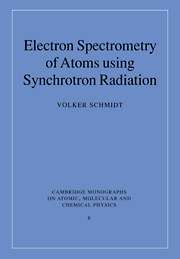Book contents
- Frontmatter
- Contents
- Corrigenda and Addenda
- Dear Reader
- Part A Background and basic principles
- 1 Introduction
- 2 Photoelectron spectrum of neon
- 3 Auger spectrum of neon following 1s ionization
- Part B Experimental aspects and recent examples
- Part C Details of specific experimental and theoretical topics
- References
- Index
1 - Introduction
Published online by Cambridge University Press: 21 October 2009
- Frontmatter
- Contents
- Corrigenda and Addenda
- Dear Reader
- Part A Background and basic principles
- 1 Introduction
- 2 Photoelectron spectrum of neon
- 3 Auger spectrum of neon following 1s ionization
- Part B Experimental aspects and recent examples
- Part C Details of specific experimental and theoretical topics
- References
- Index
Summary
Theoretical background and general aims
In the non-relativistic limit, the electronic structure of an atom is determined by the Coulomb interaction between the electrons and the nucleus and the Coulomb interaction between the electrons themselves. In the relativistic case, other interactions have to be added, of which the spin–orbit interaction represents the largest contribution. The complete and exact description of these forces in the atom follows from quantum electrodynamics which is nowadays a well-established theory. Therefore, structure studies in atoms as compared to other systems (nuclei or elementary particles) have the advantage of involving forces which are known exactly. However, even for an ideal case it is extremely difficult accurately to calculate the atomic parameters for a many-electron system. As an example the structure of the helium atom in its ground state wavefunction will be discussed, first within the model of independent particles and then for two types of wavefunction which take into account electron correlations, i.e., the correlated motions of the electrons. The fundamental features demonstrated for this relatively simple case can then also be applied to the more complicated dynamical process of photoionization. Here the observed effects of electron–electron interactions and their theoretical treatment brought a renaissance of atomic physics with exciting new insight into the structure and dynamics of atoms interacting with photons, and this aspect will appear in many places throughout the book.
Atomic structure
In order to understand atomic structure, some results from quantum mechanics have to be recalled.
- Type
- Chapter
- Information
- Publisher: Cambridge University PressPrint publication year: 1997

